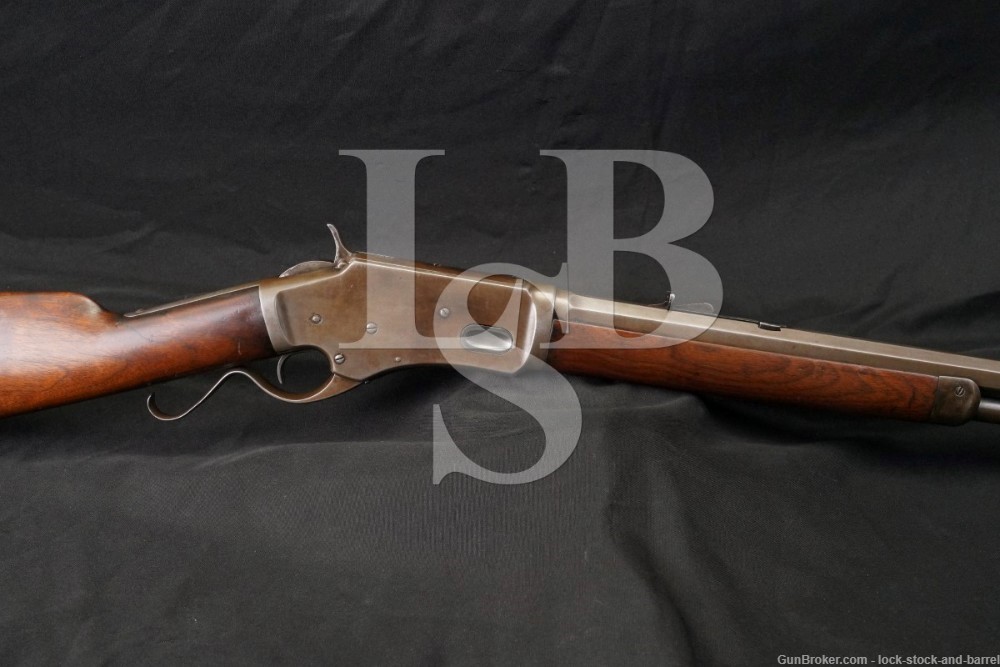
Whitney-Kennedy Carbine .44-40 WCF 24″ Lever-Action Repeating Rifle Antique
Sold for $2335.00
LSB#: 220906MC003
Make: Whitney Arms Co.
Model: Whitney-Kennedy Lever Action Repeater (also known as the Whitney-Kennedy-Teising), Sporting Rifle variant
Serial#: A452
Year of Manufacture: Circa 1879-1883, Antique
Caliber: .44-40 Winchester Centerfire
Action Type: Lever-Action Repeating Rifle with a Tubular Magazine
Markings: The top of the barrel is marked “WHITNEYVILLE ARMORY, CT. U.S.A.” and “KENNEDY” ahead of the rear sight and “44 CAL. C.F.” The top tang is marked “PAT’D JANY. 7-73. / AP’L 1. (2) MAY 13. & AUG. 12-79.” (the January 7th, 1873 and April 1st, 1879 patents were held by Andrew Burgess, the May 13th, 1879 patent was held by Samual V. Kennedy and the August 12th, 1879 joint patent of Samual V. Kennedy and Frank W. Tiesing). The bottom tang features the serial number “A452”. The left side of the lever is marked “4 52”.
Barrel Length: 24”, Octagonal
Sights/ Optics: The front sight is a blade slotted in a base dovetailed by the muzzle. The rear sight is a “V”-notch leaf dovetailed over an elevator piece.
Stock Configuration & Condition/ Grip: The stock is two-piece wood featuring a forend with a metal cap, a slot in the forend for the tubular magazine, a straight grip, a straight comb and a metal butt-plate with a storage container. The stocks have light-moderate handling marks, nicks and scuffs with a more notable scuff on the left side of the forearm near the rear. Notably, there is a small amount of material loss at the toe as well as on the left side of the wrist at the upper edge. There is also a thin crack on the right side of the wrist. The LOP is 12 3/8” from the trigger to the rear of the butt-plate. The butt-plate shows a deep patina and has scattered nicks and scratches. The storage compartments brass cover is tarnished. Overall, the stocks are in Fine condition as Antique.
Type of Finish: Blue and Case Color
Finish Originality: Original
Bore Condition: The bore is gray and has rounded yet defined rifling. There is scattered moderate erosion concentrated in the grooves and some scattered pitting.
Overall Condition: The rifle retains about 5% of its metal finish. The rifle has mostly taken a light patina color, but some ramining blue can be seen on the lower shoulders of the barrel. There are scattered light to moderate handling marks, nicks and scuffs on the gun’s metal surfaces. There is light wear along the leading edges, scattered light nicks and scratches on the frame, some sparsely scattered light pitting. Also, there is scattered light wear on the dust-cover and some light wear on the hammer. The markings remain mostly clear, those on the top tang are slightly faded. The screwheads are lightly tooled and remain serviceable. Overall, the rifle is in Very Good condition for an Antique.
Mechanics: The action functions correctly. We have not fired this rifle. As with all used firearms, a thorough cleaning may be necessary to meet your maintenance requirements.
Box Paperwork and Accessories: None.
Our Assessment: Whitney Arms Co. was a firearms manufacturer established by the famous inventor Eli Whitney at the end of the 18th century (he is most famous for the Cotton Gin). The company primarily made martial arms for the U.S. Government during its early years before Whitney passed away in 1825. His one son, Eli Whitney Jr., was only four years of age at the time, and the management of his arms factory was taken over by his sisters’ two sons Philos and Eli Whitney Blake until his son was old enough to take an active role in the family business. Following his graduation from Princeton in 1841, Whitney Jr. went to assume control of his father’s armory. When his father had initially established the business, government contracts were the most profitable avenue for an arms company, but by the time Whitney Jr. assumed control the situation had changed and a robust commercial market for firearms had emerged fueled by the Westward Expansion and urban middle class. While Whitney Jr. would still make arms for the government, he also manufactured a variety of arms on the commercial market.
This particular specimen is a Whitney Kennedy-Tiesing Lever Action Repeating Carbine. The gun is a redesigned version of the Model 1878 Burgess Repeater which was redesigned by Samual V. Kennedy and Frank W. Tiesing which was designed to chamber the .44-40 Winchester Center Fire cartridge (a popular round at the time). The gun incorporates both Andrew Burgess’ patents (who designed the Burgess Repeater) in addition to a patent held by Kennedy and a joint patent held by Kennedy and Tiesing. The gun has the serpentine or “S” shaped lever of the early production carbines made until mid-1883 (the gun was discontinued in 1886). This is a sporting variant of the iconic design and not one of the few sold to several Latin American countries for military service. The gun has wear consistent with an Antique firearm, but it remains markedly well preserved. This is a great option for fans of historical firearms. Please see our photos and good luck!
